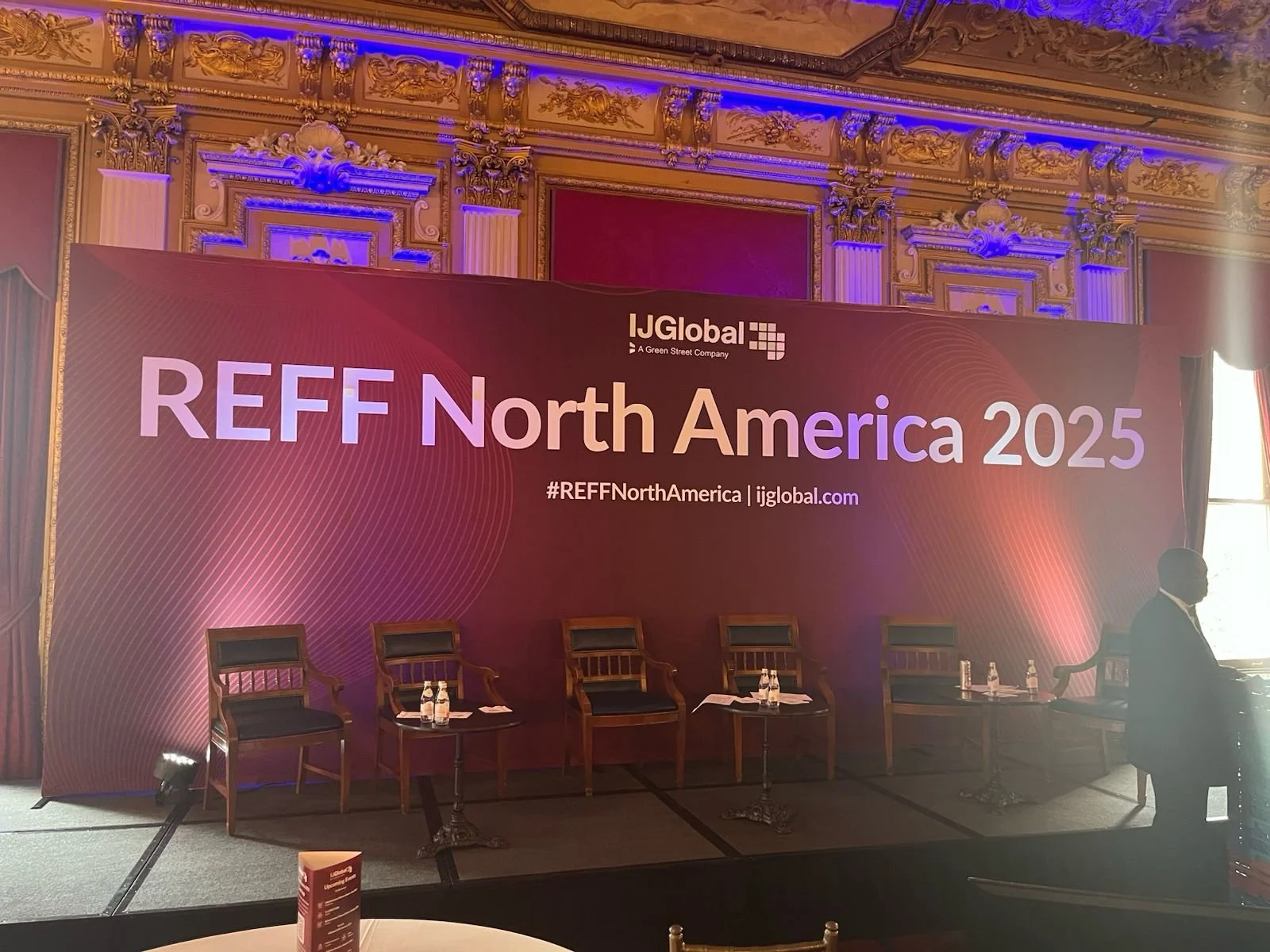Reflection on the Renewable Energy Finance Forum (REFF) North America 2025
By Abhishek Raj
Attending the Renewable Energy Finance Forum (REFF) North America in New York this year was an incredibly enriching experience. As someone seeking to build a career at the intersections of finance and sustainability, being in a room filled with decision-makers, investors, developers, and policymakers reaffirmed my belief in the transformative potential of finance in driving the clean energy transition. The event served as a valuable platform to understand how financial structures, policy shifts, and market innovations are shaping the future of renewable energy in North America.
From the outset, the forum stood out for the depth of its discussions and the quality of engagement it fostered among participants. Conversations were not limited to the usual themes of project finance or investment appetite. They reflected the rapidly evolving realities of an industry now deeply influenced by data center demand, grid constraints, and shifting policy dynamics. Over two days, I gained not only insights into technical and financial trends but also a clearer view of how investors and developers are adapting to a changing policy environment and an increasingly competitive energy market.
One of the most thought-provoking sessions was the opening discussion led by Angus Leslie Melville, which set the tone for the conference. The panelists explored how the renewable energy landscape had evolved from 2024 to 2025, focusing particularly on the implications of the H.R.1 One Big Beautiful Bill Act. This legislation, often described as one of the most consequential pieces of energy policy reform in recent years, has introduced new dynamics for clean energy financing and project development. Through the session, I learned how the Act’s proposed changes to existing incentives, tax structures, and permitting processes are reshaping investor behavior.
Panelists such as Himanshu Saxena, CEO of Lotus Infrastructure Partners, and Priyanka Duvvuru, Principal at S2G, provided valuable perspectives on how the industry is responding. While there was general optimism about long-term growth, many acknowledged that the H.R.1 Act had introduced short-term uncertainty. Developers and financiers are now re-evaluating project pipelines and investment strategies to account for potential changes in federal tax credits and policy support. The discussion helped me appreciate the interconnectedness between legislation and market confidence. It was a reminder that understanding policy risk is as important as understanding financial returns in the renewable energy business.
Another session that particularly stood out was “Renewables Finance in 2025 and Beyond,” which brought together senior representatives from Brookfield Asset Management and Innergex Renewable Energy. They discussed how investors are balancing short-term market volatility with long-term decarbonization goals. The speakers emphasized that while higher interest rates and supply chain challenges have created headwinds, strong institutional demand for renewable assets continues to support deal flow. What I found most interesting was their approach to portfolio diversification, moving beyond traditional solar and wind toward energy storage, hybrid projects, and grid infrastructure investments. This conversation reinforced my understanding that the future of clean energy finance will depend on integrating multiple technologies and revenue streams into bankable structures.
The session on data centers and AI-driven energy demand was another highlight. With data centers emerging as a major driver of electricity consumption, panelists discussed the challenges and opportunities this trend presents. The forecast that AI-related power demand could add the equivalent of California’s current power consumption to the U.S. grid by 2027 was striking. Industry leaders such as Preston Schultz from Hecate Energy and Edward Casserley from Stonepeak explored how developers are rethinking site selection, grid interconnection, and project timelines to meet this new wave of demand. The discussion also touched upon the controversial issue of using fossil fuel-based backup power for AI data centers under the government’s emergency energy declaration. I found this conversation particularly useful for understanding how new forms of demand are influencing not just energy supply but also financing strategies, given that investors must now evaluate projects through the lens of both sustainability and reliability.
In the afternoon sessions, I attended “When Green Turns Red: Restructuring Challenges in Renewable and Clean Energy,” which was led by experts from Paul Hastings and BRG. This panel offered a candid look at the financial distress some projects are facing due to rising costs, permitting delays, and tightening capital markets. I appreciated how the discussion went beyond theory to address practical restructuring strategies such as bridge financing and stakeholder alignment mechanisms. It underscored the need for flexibility and proactive risk management in renewable energy finance, which is a valuable takeaway for anyone planning to work on project structuring or credit risk assessment in this space.
On the second day, the focus turned to the Inflation Reduction Act (IRA) and its evolving implications. The session titled “The IRA and Its Future” was particularly insightful. Speakers such as Nick Addivinola from Nautilus Solar and Lydia Li from Arevon reflected on how the IRA has shaped investment decisions over the past three years and how potential revisions under the H.R.1 Act could influence project economics. One of the key debates centered on the uncertainty around grandfathering provisions for projects that have already commenced construction under the IRA framework. This helped me understand how developers and financiers are using instruments like insurance products and tax equity partnerships to mitigate policy-related risks.
The subsequent session on “Tax Equity and ITC Monetization” built on this theme by examining how the U.S. tax equity market has evolved. Hearing from Hannah McGovern of DSD Renewables and David Flory of Avantus clarified how tax equity remains a cornerstone of renewable finance but is also undergoing rapid change as new intermediaries and brokers enter the market. I learned how tax credit transfers, a relatively recent mechanism introduced under the IRA, are increasing liquidity and creating new participation avenues for smaller investors. For me, this session bridged the gap between policy design and financial execution as it demonstrated how legislative instruments can catalyze market innovation when properly implemented.
Later in the day, the “Innovations in Debt Financing” panel featuring Thomas Hopkins from Deriva Energy and Maximilian Heering from NY Green Bank was particularly relevant to my professional interests. The conversation explored how green banks and private lenders are stepping in to fill financing gaps in the mid-market project segment. The speakers emphasized the growing importance of state-backed development bonds and the emergence of private credit funds targeting infrastructure debt. This session deepened my appreciation of how diverse sources of capital are converging to meet the enormous financing needs of the energy transition. It also highlighted the importance of innovative financial structures in ensuring that the clean energy transition remains equitable and inclusive.
Beyond the formal sessions, one of the most valuable aspects of REFF North America was the networking it facilitated. Throughout the event, I had the opportunity to engage with professionals representing a broad cross-section of the renewable energy finance ecosystem including asset managers, developers, consultants, and policymakers. These interactions were not limited to surface-level introductions. Many turned into meaningful exchanges about career paths, project experiences, and emerging trends. I was particularly inspired by conversations with young professionals working in structured finance and investment advisory who shared how they navigated their own transitions into the clean energy space.
The coffee breaks, lunch sessions, and evening reception offered ideal settings for these exchanges. I found that the event’s design encouraged open dialogue, with senior executives readily sharing advice and perspectives with students and early-career professionals. One memorable conversation I had was with an investment manager at a private credit fund who described how her firm evaluates grid infrastructure projects for resilience and scalability. Her insights on how lenders assess risk in long-tenor clean energy projects were directly relevant to my current academic focus on infrastructure finance.
Networking at REFF also gave me a clearer sense of where I want to position myself in the clean energy finance value chain. Listening to both investors and developers made me realize that bridging the gap between technical project design and financial structuring is a key area where I can contribute. The conference reaffirmed my goal of working on blended finance mechanisms and catalytic capital solutions that can de-risk investments in emerging markets, a topic I have been deeply interested in since my prior work in India’s sustainable finance sector.
What made REFF particularly useful from a career standpoint was its ability to connect macro-level discussions such as the implications of H.R.1 and IRA revisions with micro-level insights on deal structuring, tax equity, and debt financing. For someone aspiring to work in clean energy finance, understanding how these layers interact is crucial. The conference helped me see how financiers are balancing commercial viability with climate objectives, and how innovation in financial products is essential to bridge the funding gap for renewable projects.
In retrospect, attending REFF North America was more than just a learning experience. It was a professional milestone. The discussions deepened my understanding of how policy, finance, and technology are converging to accelerate the energy transition. More importantly, the event provided a network of people and ideas that I know will shape my career journey in the years to come.
I left the conference with a renewed sense of purpose and clarity about my role in the clean energy ecosystem. As the sector continues to evolve, events like REFF remind me that collaboration and innovation, underpinned by sound financial strategy, will be the foundation of a sustainable future.
Abhishek is a second-year MIB student specializing in sustainable finance and environmental policy, with a strong interest in financing and scaling decarbonization solutions.


